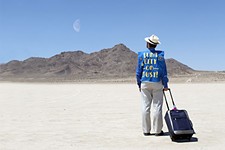Something Weird
How Tim League Discovered 110 Drive-In Films in an East Prairie Warehouse and Other Stories of Disappearing Celluloid
By Jerry Renshaw, Fri., Feb. 16, 2001

There's not a whole lot to recommend East Prairie, Missouri. Situated in the southeast corner of the state (in proximity to Charleston and Sikeston), there are a few stoplights, the usual assortment of chain restaurants, and four or five thousand Midwesterners. That part of Missouri isn't really even close to anything, being a several hours' drive from Memphis, Kansas City, Springfield, Jefferson City, and St. Louis. Still, in the confines of East Prairie stood a rickety warehouse containing a cache of films from the tail-end of the drive-in era: 976-Evil; the Linda Blair revenge opus Savage Streets; Euro-horror like Lamberto Bava's Demons; dimwit sex comedies like Can I Do It Until I Need Glasses? For years the movies languished, forgotten and decaying ... until recently.
Collecting prints of films, for those who have the means, is not unlike collecting baseball cards, Hummel figures, or Franklin Mint plates. There's a community of traders and collectors, and it's something that easily progresses from a hobby to an avocation to an obsession, until the collector is overrun with film cans. Like Alamo Drafthouse owner Tim League.
League has spent considerable time on the inside track of the collector's world, driven partly by business necessity and partly by a love of the game. Some time earlier, he made the acquaintance of Harry Cuero of New Jersey's Exhumed Films. ("It's sort of a double meaning," notes League, "because they're film collectors, but they deal almost strictly in horror and exploitation stuff.")
Initially, League was tipped off to the drive-in prints by his pal Cuero. The East Prairie warehouse had previously been a depot for Clark Films, a long-defunct distributor of movies for the drive-ins of the South and Midwest. Clark was later absorbed by Dimension (which in turn became a Miramax subsidiary), but the East Prairie warehouse was apparently forgotten in the transition.
The decrepit warehouse was bought by an East Prairie businessman, an all-around pillar of the community (we'll call him the King of East Prairie), who viewed its contents as little more than junk cluttering up the place. Harry Cuero, in turn, caught wind of the King's desire to liquidate the films and traveled to Missouri to bring back what he hoped would be a cache of prints. Cuero's hopes were dashed, though, once he got to the Missouri warehouse. Many prints were water damaged from sitting under a leaky roof. Others were "vinegarized," the result of a chemical reaction that occurs when the film is exposed to fluctuations in temperature and humidity. Still others were hopelessly battered and spliced from being run through too many projectors and handled carelessly.
"Harry went down there and wound up writing off about $1,500 in travel expenses and said, 'No, I'm not gonna do it because the price is too highí'" League recalls. "Harry got in a big screaming match with the old guy and severed all of his ties on the deal. The guy wasn't in a mood to dicker and wasn't any too diplomatic about it."
Eventually, League made the trip to Missouri himself, by which time, the old man had at least picked up the prints and moved them into an abandoned movie theatre with a solid roof, heading off any further water damage. Wisely leaving out Cuero's name, League struck a deal with the irascible King of East Prairie, who had apparently grown sick of looking at the stuff. "By that time, a year and a half had gone by, and they were still just sitting there," League says. "He agreed on the price, and there were really no hitches once I got there, and I loaded it all out in one day. It was just something that was taking up space in a building that he could be renting out." League filled a Ryder truck from floor to ceiling, front to back, with the film cans and drove the overloaded truck back to Austin, not daring to exceed 50 mph the whole way.
Once safely back in Austin, League took on the daunting task of figuring out what prints were there (and which ones were salvageable). Contrary to what his pal Cuero thought, many films inside rusted, filthy cans turned out to be in pristine condition. On the other hand, some spotless cans contained reels that looked more like Bundt cakes than film; they were ruined beyond hope. About 40 of the prints were so wrecked by water, dirt, or vinegarization that they had to be scrapped. Many of those wound up in the hands of Film Action's Luke Savisky, who plans to use fragments of them for an installation to eventually be shown at the Alamo.
After all the work, though, the haul yielded a considerable archive of drive-in, exploitation, and horror junk -- some obscure, some better known. Among the titles are some that will set the trash moviehound's mind ablaze ...

... and the list goes on -- 110 titles in all -- with another 10 or 15 partial prints to boot. Some titles are so obscure they don't even have listings in the exhaustive files of the Internet Movie Database (www.imdb.com). The Alamo plans to screen the drive-in movies every Wednesday at midnight, free of charge, under the name "Something Weird Wednesdays" (see sidebar for schedule). With so many titles, it's likely to become a long-running series at the theatre. It may not be quite the same as sitting in the back of your truck at the drive-in, swatting bugs, drinking Pabst, and listening to the squawk of a metal speaker, but the true trash-movie aficionado won't find a better deal in town.
America's No. 1 Crackpot Video Company
League's story of unclaimed, forgotten movies is not entirely unique. More than one business has been started in much the same way as the Alamo acquired its prints. Take, for example, Mike Vraney -- the self-proclaimed King of Crackpot Cinema. After years of working in drive-ins and 50-chair storefront grindhouse cinemas, he started Seattle's Something Weird Video (weirdly enough, not affiliated with the Alamo's film series) in the mid-Eighties, having recognized a niche market for forgotten and obscure films to be released on video, a niche no one else was filling.
"It mainly had to do with AIP [American International Pictures, home turf of director Roger Corman] features and other stuff that I'd seen as a kid or read about, bondage and whatnot," says Vraney. "I came up with titles and screened 'em, thinking, 'Boy, none of this is on tape, like naked girls just walking around on rocks in 1952.'"
In time, Vraney's efforts drew the attention of David S. Friedman, onetime partner of drive-in horror/schlock director Herschell Gordon Lewis and man of many hats in the exploitation film world of the Fifties and Sixties. Friedman gave him access to his film vault in Los Angeles, where scores of negatives sat rotting in their film cans. Vraney toiled over the negatives, struck prints of them, transferred them to video, and began to market them. Staying on the fringes of the video world, he did an end run around the usual video distribution channels and went instead for the comic book distributors. "I approached the comic book industry in about '89 or '90, saying 'Look, I've got this stuff, it's very pop culture, Americana, adult-oriented but soft, not hardcore, fascinating stuffí'" recounts Vraney. "I lucked out. Two of the biggest distributors at the time were run by old guys in their 70s, and they knew what my stuff was immediately. I also had [8mm stag films with pin-up queen] Bettie Page, so they all said 'Woo-hooí' and I tapped into this distribution that nobody else had thought of."
After receiving his first royalty check from Vraney, Friedman gave him the key to the vault and told all his friends. With Friedman's distributor pals sniffing the scent of mailbox money, Something Weird soon had access to entire libraries -- lock, stock, and barrel -- with complete rights to all the materials.
Subsequent years found Vraney and SWV going on countless safaris like Tim League's to retrieve more crackpot movies and pop-culture arcana. One trip involved an astonishing total of 14 40-foot tractor-trailers toting negatives from an abandoned movie lab slated for demolition, a haul of 22,000 film cans. As a result, Something Weird's catalog not only includes horror, action, and exploitation titles -- there are also scores of early Sixties nudie films, stag-movie loops, drive-in intermission footage, trailers of every description, and mind-numbing classroom, industrial, instructional, and safety films. Watching those movies, you can almost hear the dry whir of a l6mm Bell and Howell A/V Club projector in a stuffy classroom. Many of these titles are available for rental at Vulcan Video (or for purchase through the company's Web site, www.somethingweird.com.) You can usually spot Something Weird's output by the gaudy box art -- lurid and eye-catching, often taken from the movie's original poster art. The films -- from exploitation to education -- track an American culture where norms and mores are changing at a rapid pace.
The Big Picture
Of course, recovering exploitation and drive-in movies is only a tiny sliver of a much larger issue. More than half of the films made on nitrate film stock before 1950 have disappeared. Of films made before 1929, only about 10% remain today. Eastman color and Kodak color films made between 1950 and 1975 are literally fading away, their color values disappearing in washes of pink, purple, or yellow as they languish in film vaults. Countless negatives for acknowledged classics are gone forever. Such beloved films as The Magnificent Ambersons, Dr. Strangelove, The Ox-Bow Incident, and Stagecoach have had entirely new prints struck, with the negatives lost to the ages. That's not even considering the public domain films, shorts, newsreels, documentaries, and the like from the period, or vintage TV footage that was transferred to videotape, then lost or destroyed (not one minute of the early-Fifties kiddie favorite Captain Video still exists).
There are plenty of things that have come together to create this situation. Nitrate-based celluloid stock was the standard before 1950 or so, yielding a shimmering image that gave films from the day their distinctive look. Unfortunately, nitrate reacts with air to produce nitric acid, corroding films as they sit in storage. Nitrate stock is also highly flammable and nearly impossible to extinguish once it ignites. Carbon-arc projectors sparked many a projection-room fire (ô la Cinema Paradiso), with the equivalent of a welding torch in close proximity to combustible film. In plenty of instances, films spontaneously combusted as they sat in the cans. The negatives of Singin' in the Rain and Citizen Kane fell victim to nitrate fires over the years.
Nitrate was replaced by safety stock in the 1950s, but safety stock came with its own problems. Vinegarization, shrinkage, and brittleness tend to afflict later films; producer George Stevens Jr. was called on to strike a negative from his print of The Diary of Anne Frank, since the original negative was ruined. Hence, this film will forever exist only in a degraded state.
For years, the industry's answer to many issues of film storage was to transfer the movie onto a master videotape, simply discarding the original or leaving it to rot. Storing prints and negatives of films properly was looked at as overhead, an expense that cut into the profits of studios and distributors. Too often, the transfers were careless, with little thought given to the film's original aspect ratio (height vs. width of the screen image) or even whether the movie was supposed to be in widescreen or not. Some movies fell victim to the Eighties scourge of colorization. Also, the transfer, given the quality of videotape technology at the time, invariably compromised the clarity of the film image.
In the past 15 or 20 years, film preservation has started to receive the attention it's due. Cable networks American Movie Classics and Turner Classic Movies have put resources toward film restoration and preservation. Filmmakers like Martin Scorsese, Clint Eastwood, Woody Allen, Francis Ford Coppola, Sydney Pollack, and George Lucas have formed the Film Foundation, which raises money for and awareness of film preservation issues (Scorsese in particular has seen it as a cultural imperative). Now the studios have put their weight toward preservation and restoration efforts, along with several archives and film labs around the country. Of course, preserving film isn't entirely altruistic; there's money to be made from running restored films on cable networks or re-releasing them for theatrical runs. Kodak's George Eastman House has one of the pre-eminent archives, with prints of such extremely rare film treasures as Georges Méliès' films from the turn of the century, the Lumière brothers' first experiments with film, a 1920 rendition of Sherlock Holmes starring Basil Rathbone, and all the silent films of Cecil B. DeMille, King Vidor, Thomas Ince, and others. Eastman's collection also includes all the remaining silent films of Louise Brooks and Greta Garbo, as well as thousands of stills, posters, screenplays, and other paper artifacts from film history. Much of Eastman House's efforts also go toward transferring nitrate films onto acetate safety stock, as well as scientific research into proper storage techniques for preserving film.
Still, despite the best efforts of collectors and restorers, many films are being lost forever. "Get into the film collectors' circles, and there are horror stories about film depots that aren't in existence anymore," remarks Tim League, "and all they do is take Dumpster after Dumpster load of films, for weeks on end, straight to the landfill." To prevent film degradation at the Alamo, League has invested in a newly developed print-cleaning device that squeegees the grime off the film stock as it runs through the projector, simultaneously impregnating them with a chemical that keeps the stock pliable. A lot of the current restoration, he says, "is by guys who keep films in climate-controlled rooms in their basements and show them once a year so they stay pliable. But then the studios are afraid that these are the guys who are out to cheat the system somehow."
Mike Vraney gets a little worked up when he talks about it. "We live in a transient society where we throw things away like they're nothing. For years, the majors said, 'We have a 1" [videotape] master, why do we need the negative?' They're idiots! All I've been doing since '87 is getting every negative I can find and [putting them in storage]. Now the majors are scrambling so they can get the negatives for a beautiful digital transfer. I can totally understand films lost from the Twenties or Thirties because of the nitrate stock, but it's an absolute crime that movies from the Fifties or Sixties are gone, and they were printed on celluloid! Plastic!"
Eastman House's assistant curator, Ed Strandtmann, takes a somewhat more pragmatic view of the problem. In regard to the transfer of film onto master videotapes, he notes, "There was a lot of stuff like that done poorly, or just wrong. But to be fair to those people, they didn't have the technology at the time, or didn't know what [poor storage] would do to the film. Still, [a studio or distributor is] a commercial enterprise, and it's there to make money. Sure, I feel bad that a lot of stuff was done or handled the way it was, but you have to look at it from the aspect of the times as well."
As technology races ahead and society struggles to keep up, we live in an increasingly ephemeral society. Cultural artifacts that reflect a different time, whether five or 40 years ago, are tossed away without a second thought, with only collector-packrats acting as curators of their own little museums of pop-culture goofiness. In our rush to haul everything made after WWII to the landfill, preserving and restoring movies isn't just a matter of film history; the movies are a part of our cultural heritage, the fabric of our society. Movies like Supersonic Super Girls (a 3-D stewardess flick!) may not bear the totemic weightiness of a Welles or John Ford or Howard Hawks classic. Still, movies like that aren't just garbage, they're part of pop culture and are valuable in the same way that Fifties Barbie dolls are worth $1,000 now. At least there are people like Tim League and the moviegoers of the Alamo, who can appreciate the intrinsic value, however slim, of something like Kill and Kill Again and make sure it'll be around for a while. It's a shame to think about any film, regardless of its stature, being gone forever. ![]()
Something Weird Wednesdays kicks off with the zombie thriller Shock Waves, playing this Wednesday, Feb. 21, midnight, at the Alamo Drafthouse, 409 Colorado. Admission is free. Other, presumably more popular films acquired from the East Prairie warehouse (Up in Smoke, Andy Warhol's Dracula) will run during the weekends. See www.drafthouse.com or call 476-1320 for more information.










